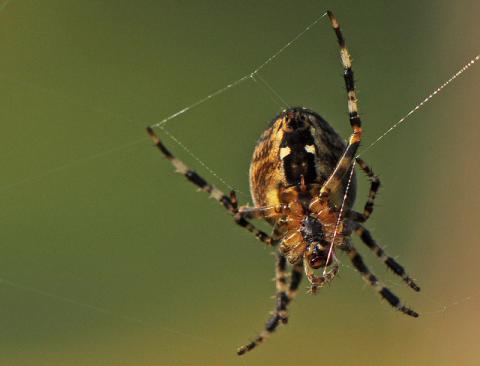This still shot, of a spider spinning a web, helps us to understand why a spider has so many legs! The photo, by Paul Boor, is copyright Paul Boor, all rights reserved. The image is provided here as fair use for educational purposes and to acquaint new viewers with Paul's work at Flickr (where his photostream appears under the name "Paul-Nature").
Spiders, like Charlotte, first start to spin their webs by squirting out a thin stream of silk which catches onto something solid like a twig or leaf. What happens next, as described by the BBC's Guide, is amazing:
The spider crawls along this strand, letting off another strand as it goes, which is attached to the original twig/leaf. When the spider reaches the other end, it lets off a little more silk, then attaches it to the other end of the original strand.
The spider now goes down to the centre of the new strand and attaches another length of silk to the centre, then drops down and attaches the end of this new strand to a leaf or twig below, forming a Y shape. The spider attaches numerous other strands to the centre of the Y, like spokes on a bicycle wheel. It then spins out a number of concentric circles around the centre, forming a very effective net.
Finally, the spider coats each strand of silk with a sticky substance to catch insects, purposefully leaving some portions of the web unsticky so that it does not get caught itself. An oily secretion from the spider's feet also helps prevent it becoming ensnared.
What is the purpose of all this work? To catch food:
When all this is done, the spider waits in the centre for something to fly into the web; when something does, it sets off vibrations which the spider can detect. When this happens, it quickly moves to the place from where the vibrations originate, kills the insect, and wraps it in silk for later.
Now that we know something about how spiders work, let's watch them in action:
- Building a section of sticky spiral.
- Attaching the sticky spiral to the web.
- Building a sticky-spiral loop (in time-lapse).
Spider webs are most beautiful when morning dew has settled on them, and the water droplets sparkle in the sun. Let's examine a few samples.


 Back
Back
 Next Chapter
Next Chapter

 Back
Back
 Next Chapter
Next Chapter

